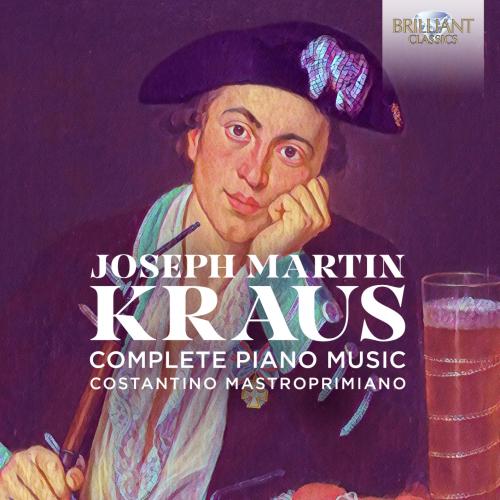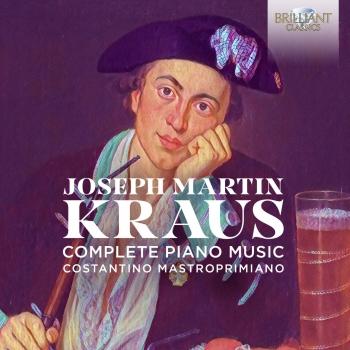
Kraus: Complete Piano Music Costantino Mastroprimiano
Album info
Album-Release:
2021
HRA-Release:
28.05.2021
Label: Brilliant Classics
Genre: Classical
Subgenre: Instrumental
Artist: Costantino Mastroprimiano
Composer: Josef Martin Kraus (1756-1792)
Album including Album cover
- Joseph Martin Kraus (1756 - 1792): Kraus:
- 1 Kraus: 2 Neue Kuriose Minuetten, VB 190 02:03
- 2 Kraus: Rondo in F Major, VB 191 08:17
- 3 Kraus: Svensk Dans, VB 192 03:46
- 4 Kraus: Thema con variazione, VB 193 11:08
- 5 Kraus: Larghetto, VB 194 00:48
- Kraus: Sonata in E-Flat Major, VB 195:
- 6 Kraus: Sonata in E-Flat Major, VB 195: I. Allegro Moderato 08:27
- 7 Kraus: Sonata in E-Flat Major, VB 195: II. Andante con Variazione 09:20
- 8 Kraus: Sonata in E-Flat Major, VB 195: III. Allegro ma non troppo Presto 07:46
- Kraus: Sonata in E Major, VB 196:
- 9 Kraus: Sonata in E Major, VB 196: I. Vivace 07:13
- 10 Kraus: Sonata in E Major, VB 196: II. Adagio 04:17
- 11 Kraus: Sonata in E Major, VB 196: III. Allegretto - Adagio - Arioso 05:53
- 12 Kraus: Sonata in E Major, VB 196: IV. Andante con Variazione 10:43
Info for Kraus: Complete Piano Music
Joseph Martin Kraus, regarded in his lifetime (1756–1792) as one of the world’s six most formidable composers, has like many other contemporaries since languished in the historical shadow of Mozart. Kraus was hailed by none other than Joseph Haydn as Mozart’s equal in terms of creativity and genius but had a career more like Haydn’s and was more of a polymath. Born in central Germany, he studied composition in Mannheim, Mainz, Erfurt and Göttingen. In 1778 he decided on a career in music and emigrated to Sweden, where he became Vice-Kapellmeister at the court of Gustav III in 1781 and Kapellmeister in Stockholm in 1788.
Trained as a violinist (who, like Mozart, preferred the viola), he nonetheless was a talented pianist. Francisco de Miranda, a nobleman on a grand tour in 1787, described Kraus playing the fortepiano ‘like an angel’. Sadly, the composer left relatively few works for the keyboard. This disc provides a thorough exploration of these works, from the satirical to the sublime, the expansive to the perfunctory, with the real tours de force being the two fortepiano sonatas, both issued in 1788 by Swedish publisher Olof Ålström.
Though limited in number, these works for solo keyboard (almost certainly composed for the fortepiano) represent the variety and originality that are among Kraus’s musical trademarks. The two sonatas in particular challenge the technical limits of the instrument, requiring both dexterity and interpretive ability and often foreshadowing the piano music of thirty years hence in content and scope.
Recorded in October 2020 in Trento, Italy. The booklet contains liner notes by musicologist Bertil van Boer and a biography of the artist Costantino Mastroprimiano plays a fortepiano by Monika May (after Johann Andreas Stein, 1771). After his death Joseph Martin Kraus has, like many others, fallen under the historical shadow of Mozart. An almost exact contemporary, Kraus was hailed by nobody less than Joseph Haydn as Mozart’s equal in terms of creativity and genius.
Kraus received his musical education in several cities in Central Germany, his birth ground. In 1778 he emigrated to Sweden, where he became Vice-Kapellmeister at the court of Gustav III in 1781. In 1782 he embarked on a four-year grand tour of Europe, meeting with colleagues in Berlin, Vienna, Venice, Rome, Naples, Paris, and London, all the while observing in his copious correspondence the trends and sights of his day. In 1788 he became Kapellmeister at the court in Stockholm.
Trained as a violinist Kraus was nonetheless an excellent pianist. This new recording presents his complete output for the instrument, consisting of several shorter character pieces and two substantial piano sonatas, representing a variety and originality that is one of Kraus’s musical trademarks. The two sonatas, especially, are at the technical limits of the instrument, requiring both dexterity and interpretive ability, often foreshadowing piano music thirty years later (Beethoven!) in content and scope.
Costantino Mastroprimiano studied piano and chamber music with Michele Marvulli, Guido Agosti and Riccardo Brengola, and then moved his focus to the study of the fortepiano.
Costantino Mastroprimiano, fortepiano
Costantino Mastroprimiano
Italian fortepianist and musicologist Costantino Mastroprimiano (b. 1964) studied at the Conservatorio di Musica, Foggia, and gained diplomas in piano and chamber music at the Accademia Chigiana in Siena. He specializes in 18th- and 19th-century piano music, especially the works of Clementi, Dussek, Hummel, Cramer, Czerny, Kalkbrenner and Moscheles. As a soloist and chamber musician he has appeared throughout Italy and Europe, and among his recordings is the award-winning 18-CD cycle of Clementi’s complete sonatas (Brilliant Classics). He teaches chamber music and pianoforte (historic performance) at the Conservatorio di Musica Francesco Morlacchi in Perugia, and gives frequent masterclasses in Italy. He is also curator and member of the editorial board of Muzio Clementi’s Opera Omnia (Urtext) published by Ut Orpheus, Bologna.
This album contains no booklet.













